目录
1.单元测试
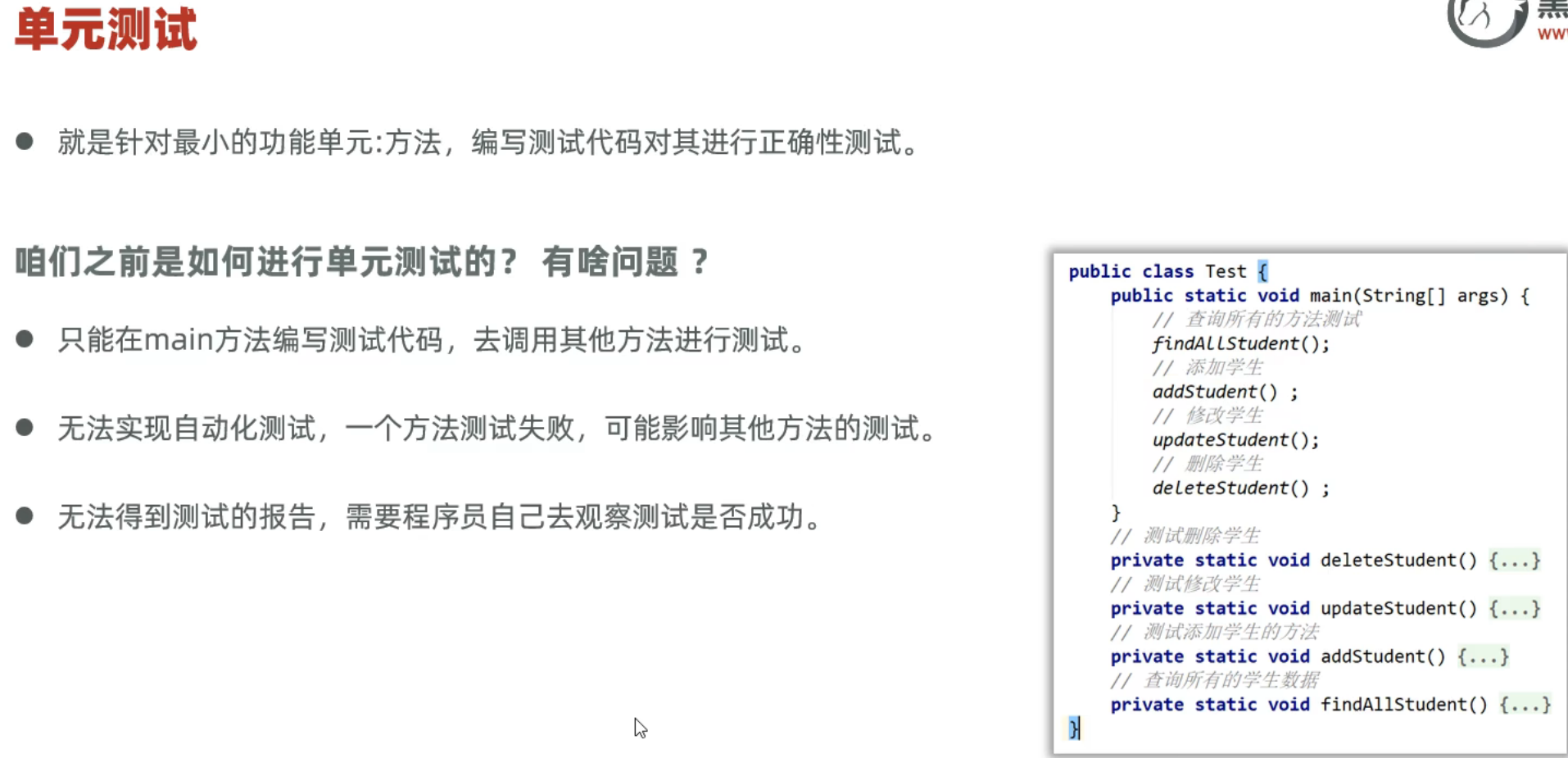
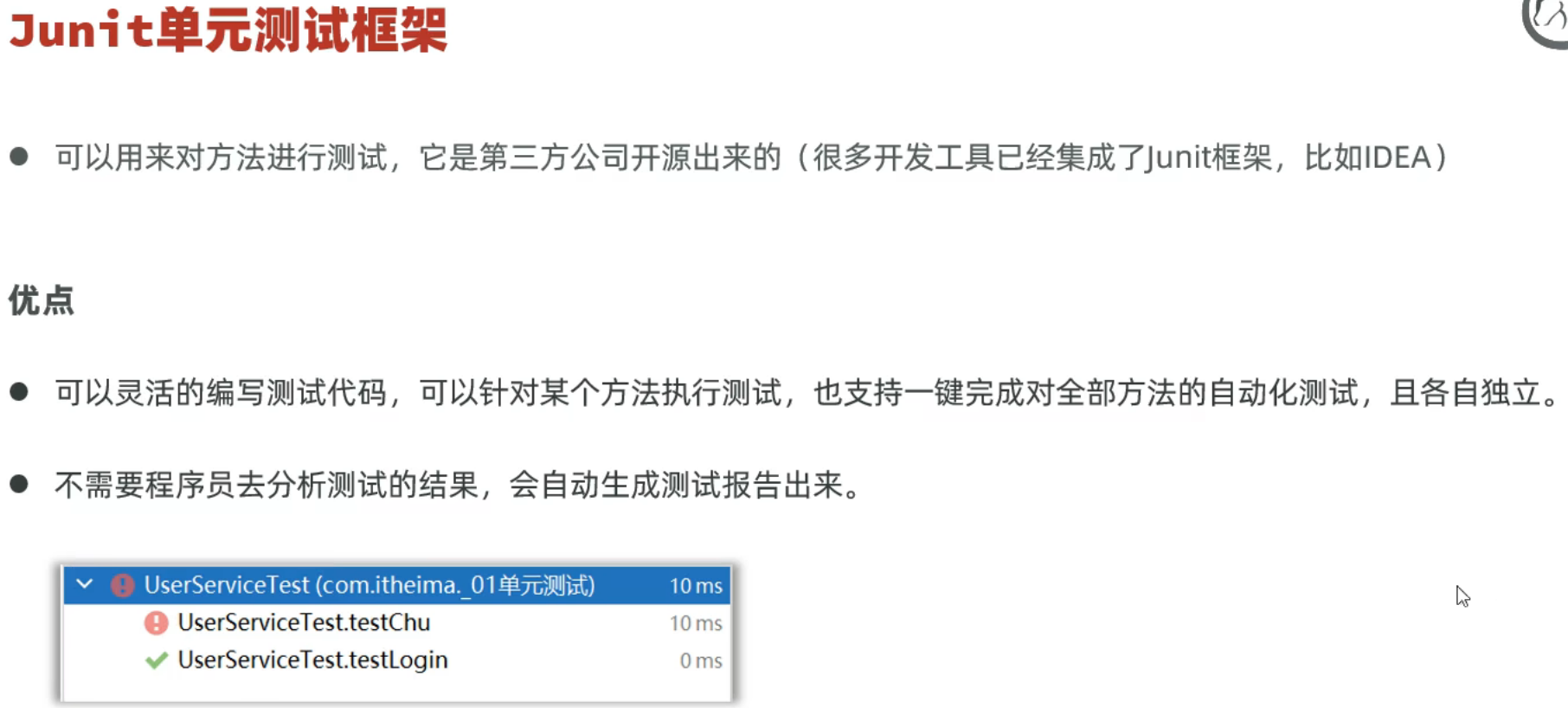
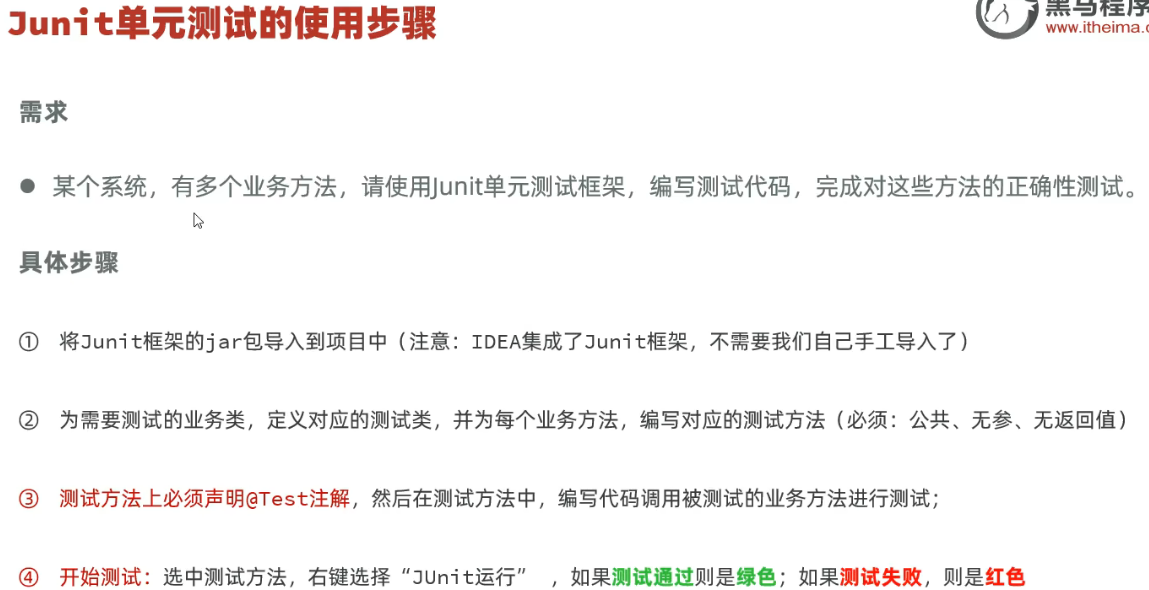
/**
* 字符串工具类
*/
public class StringUtil {
public static void printNumber(String name){
if(name == null){
System.out.println("参数不能为null");
return;
}
System.out.println("名字长度是:" + name.length());
}
/**
* 求字符串的最大索引
*/
public static int getMaxIndex(String data){
if(data == null || "".equals(data)) {
return -1;
}
return data.length() -1;
}
}
@Test
public void testPrintNumber(){
StringUtil.printNumber(null);
StringUtil.printNumber("");
StringUtil.printNumber("admin");//5
}
@Test
public void testGetMaxIndex(){
// System.out.println(StringUtil.getMaxIndex(null));
// System.out.println(StringUtil.getMaxIndex(""));
// System.out.println(StringUtil.getMaxIndex("admin"));
// 断言:预言。
int i1 = StringUtil.getMaxIndex(null);
//public static void assertEquals(String message, long expected, long actual)
Assert.assertEquals("null测试失败!", -1, i1);
int i2 = StringUtil.getMaxIndex("");
Assert.assertEquals("空字符串测试失败!", -1, i2);
int i3 = StringUtil.getMaxIndex("admin");
Assert.assertEquals("admin测试失败!", 4, i3);
System.out.println("测试通过!");
}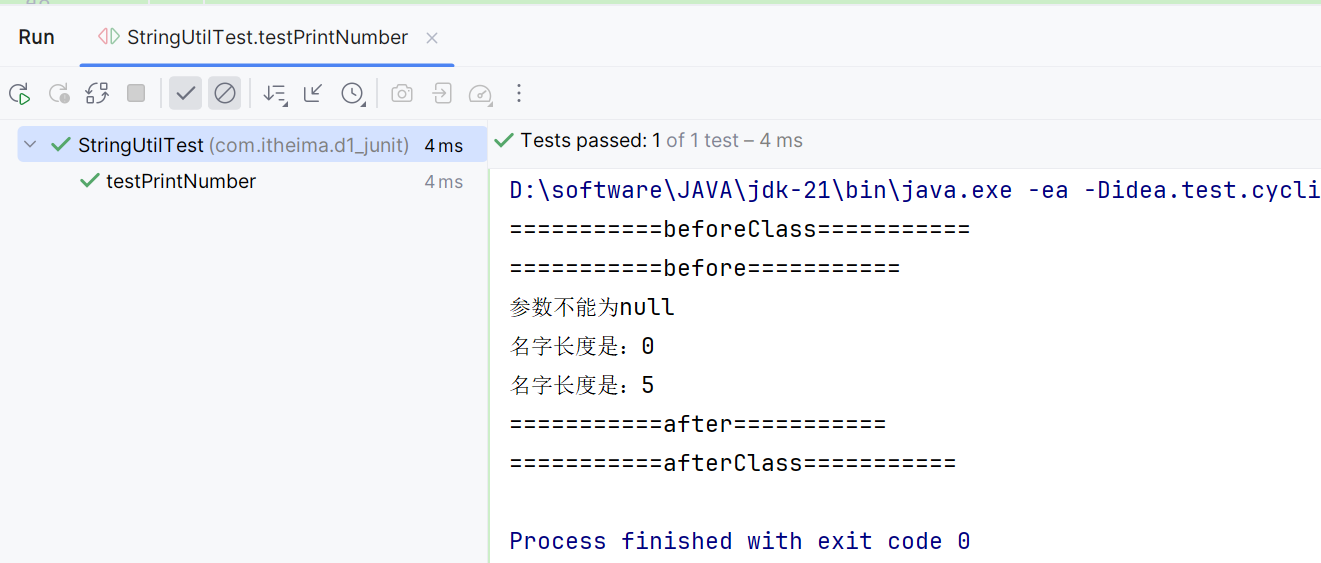
JUnit单元测试的实现过程是什么样的?
- 必须导入Junit框架的jar包
- 定义的测试方法必须是无参数返回值,且公开的方法
- 测试方法使用@Test注解标记
JUnit测试某个方法,测试全部方法怎么处理?成功的标志是什么?
- 测试某个方法直接右键该方法启动测试
- 测试全部方法,可以选择类或者模块启动
- 红色失败,绿色通过
2.反射
2.1 认识反射、获取类
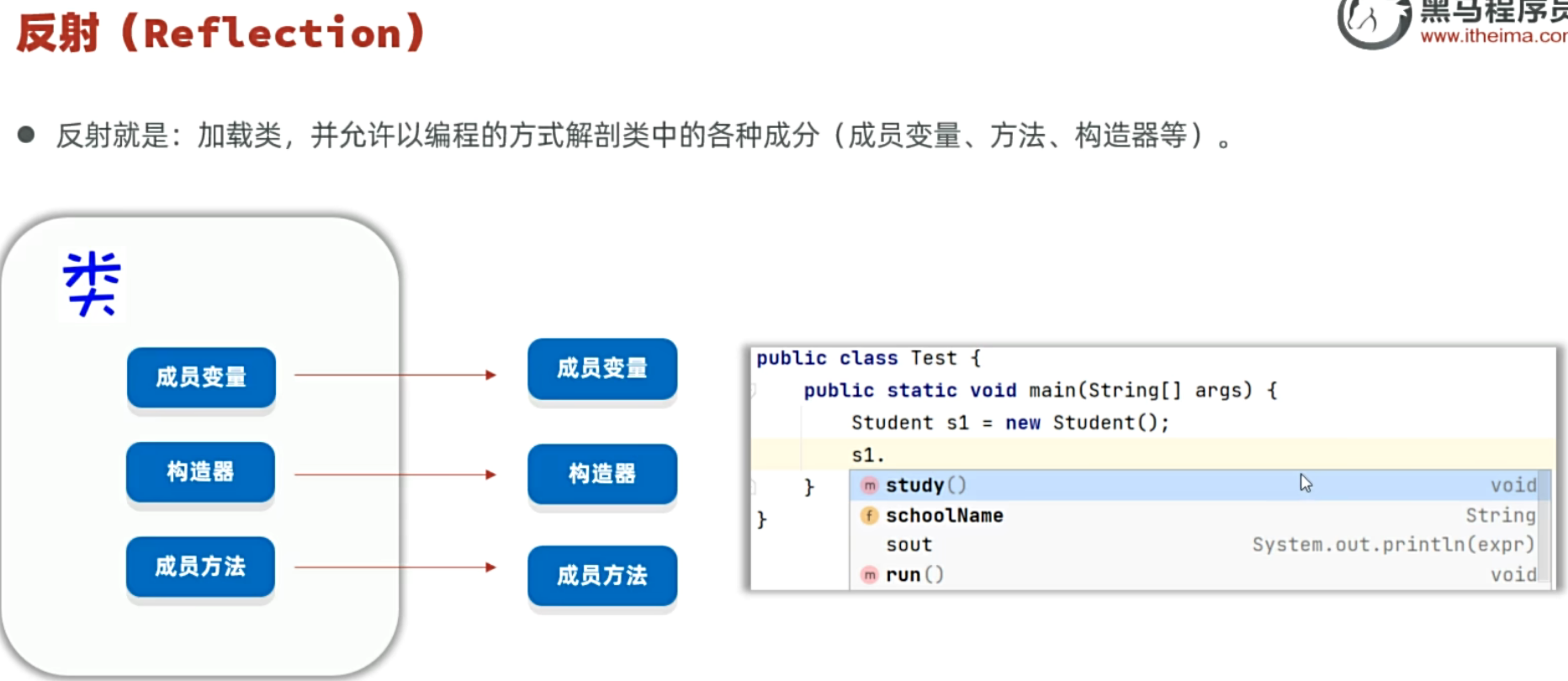
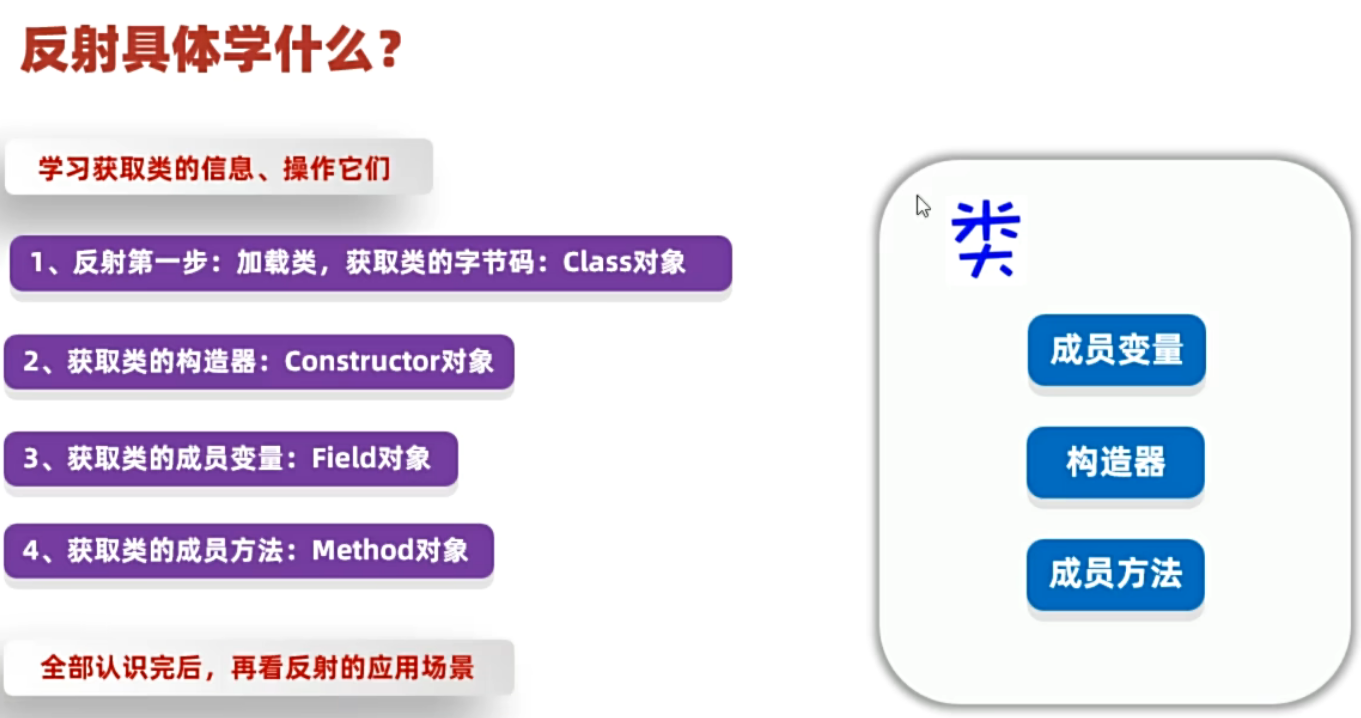
public class Student {
private String name;
private int age;
private char sex;
private double height;
private String hobby;
public Student() {
}
public Student(String name, int age, char sex, double height, String hobby) {
this.name = name;
this.age = age;
this.sex = sex;
this.height = height;
this.hobby = hobby;
}
public String getName() {
return name;
}
public void setName(String name) {
this.name = name;
}
public int getAge() {
return age;
}
public void setAge(int age) {
this.age = age;
}
public char getSex() {
return sex;
}
public void setSex(char sex) {
this.sex = sex;
}
public double getHeight() {
return height;
}
public void setHeight(double height) {
this.height = height;
}
public String getHobby() {
return hobby;
}
public void setHobby(String hobby) {
this.hobby = hobby;
}
}
package com.itheima.d2_reflect;
/**
* 目标:获取Class对象。
*/
public class Test1Class {
public static void main(String[] args) throws Exception {
// 目标:反射第一步:获取Class对象。
// 1、方式一:类名.class
Class c1 = Student.class;
System.out.println(c1);
// 2、方式二:Class.forName(全类名)
Class c2 = Class.forName("com.itheima.d2_reflect.Student");
System.out.println(c2);
// 3、方式三:对象.getClass();
Student s1 = new Student();
Class c3 = s1.getClass();
System.out.println(c3);
System.out.println(c1 == c2);// true
System.out.println(c2 == c3);// true
}
}
2.2 获取类中的成分,并对其进行操作
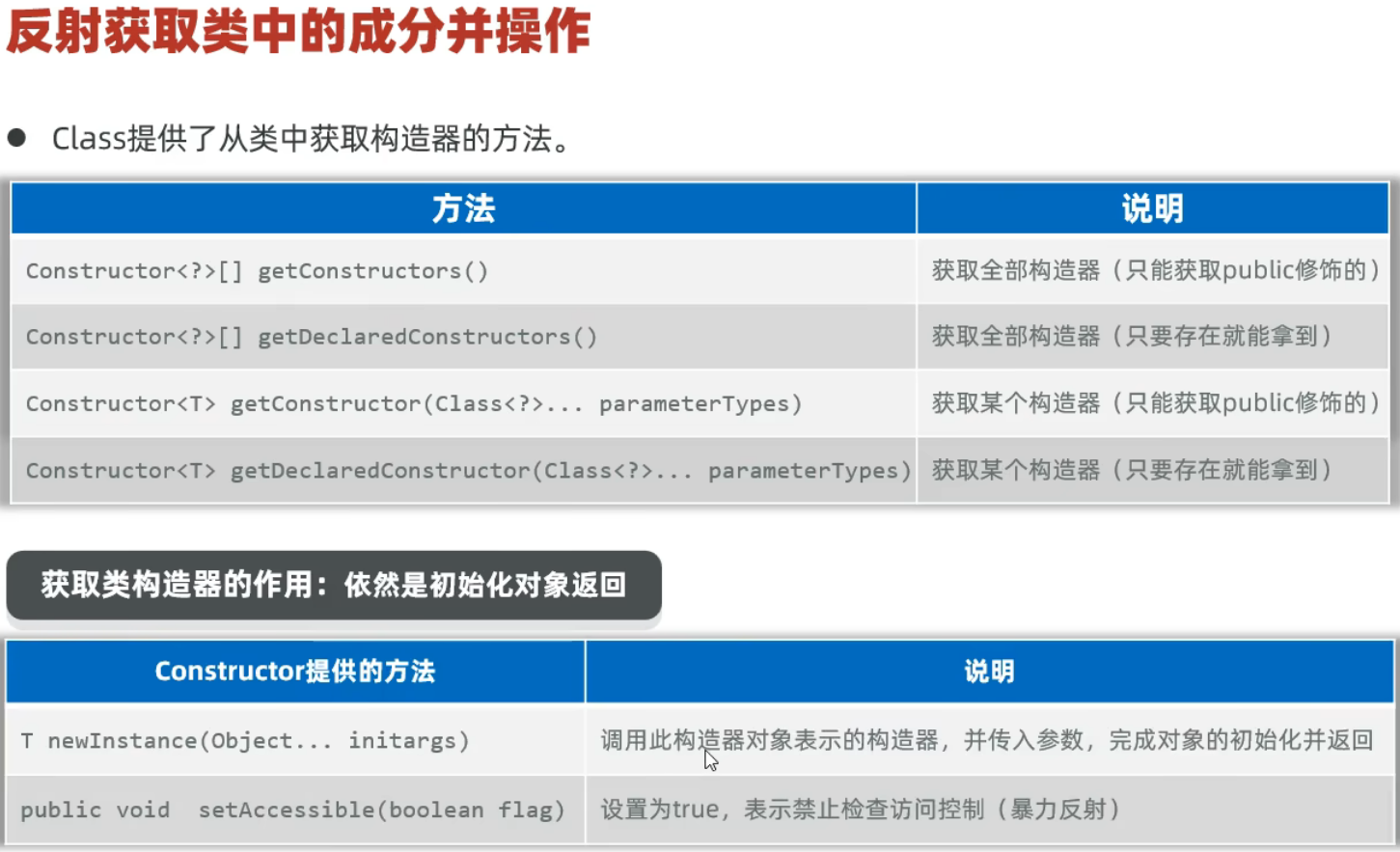

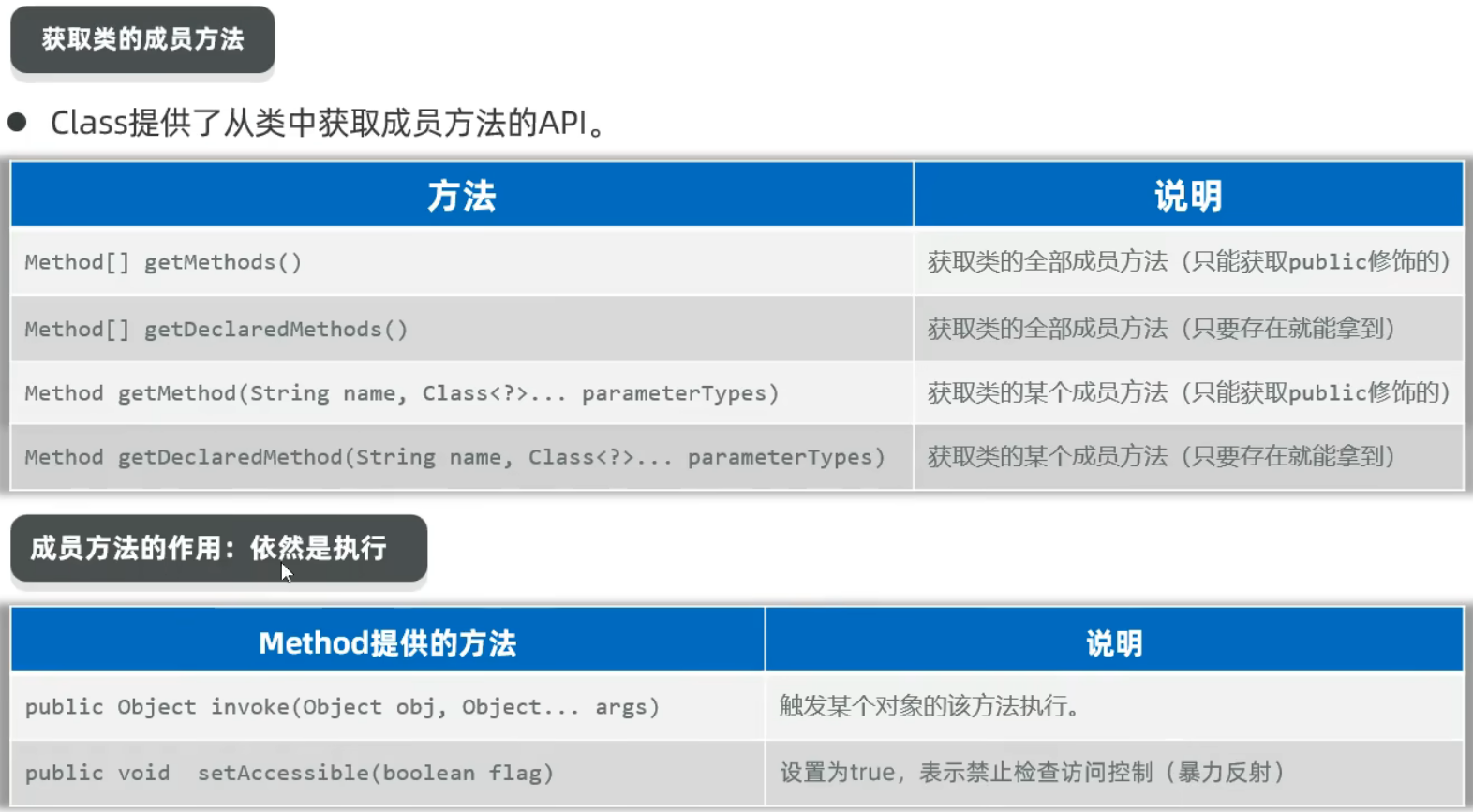
package com.itheima.d2_reflect;
public class Cat {
public static int a;
public static final String COUNTRY = "中国";
private String name;
private int age;
private String hobby;
public Cat() {
System.out.println("无参数构造器执行了~~");
}
private Cat(String name) {
System.out.println("一个参数构造器执行了~~");
this.name = name;
}
public Cat(String name, int age) {
System.out.println("有参数构造器执行了~~");
this.name = name;
this.age = age;
}
public void run() {
System.out.println("🐱跑的贼快~~");
}
private void eat() {
System.out.println("🐱爱吃猫粮~");
}
public String eat(String name) {
return "🐱最爱吃:" + name;
}
public String getName() {
return name;
}
public void setName(String name) {
this.name = name;
}
public int getAge() {
return age;
}
public void setAge(int age) {
this.age = age;
}
public String getHobby() {
return hobby;
}
public void setHobby(String hobby) {
this.hobby = hobby;
}
@Override
public String toString() {
return "Cat{" +
"name='" + name + '\'' +
", age=" + age +
", hobby='" + hobby + '\'' +
'}';
}
}package com.itheima.d2_reflect;
import org.junit.Test;
import java.lang.reflect.Constructor;
import java.lang.reflect.Field;
import java.lang.reflect.Method;
/**
* 目标:掌握获取类的构造器,并对其进行操作。
*/
public class Test2Constructor {
@Test
public void getClassInfo(){
// 1、反射第一步:必须先得到这个类的Class对象
Class c = Cat.class;
System.out.println(c.getName());//类名的全类名 com.itheima.d2_reflect.Cat
System.out.println(c.getSimpleName());//类名 Cat
}
@Test
public void getConstructorInfo() throws Exception {
//目标:获取类的构造器对象并对其进行操作
// 1、反射第一步:必须先得到这个类的Class对象
Class c = Cat.class;
// 2、获取类的全部构造器
// Constructor[] constructors = c.getConstructors(); // 只能拿public的
Constructor[] cons = c.getDeclaredConstructors(); // 存在即可拿
// 3、遍历构造器
for (Constructor con : cons) {
System.out.println(con.getName() + " ===> " + con.getParameterCount());
}
//4.获取单个构造器
Constructor con = c.getDeclaredConstructor();//无参数构造器
System.out.println(con.getName() + " ===> " + con.getParameterCount());
Constructor con2 = c.getDeclaredConstructor(String.class, int.class);//带参数构造器
System.out.println(con2.getName() + " ===> " + con2.getParameterCount());
//5.获取构造器的作用依然是创建对象:创建对象。
//暴力反射:暴力反射可以访问私有的构造器、方法、属性
con.setAccessible(true);//绕过访问权限,直接访问!临时攻破权限
Cat cat = (Cat) con.newInstance();//需要强转
System.out.println(cat);
Cat tom = (Cat)con2.newInstance("Tom", 5);
System.out.println(tom);
}
//获取类的成员变量对象并对其进行操作
@Test
public void getFieldInfo() throws Exception {
//目标:获取类的成员变量对象并对其进行操作
// 1、反射第一步:必须先得到这个类的Class对象
Class c = Cat.class;
//2.获取所有成员变量对象
Field[] fields = c.getDeclaredFields();
for (Field field : fields) {
System.out.println(field.getType() + " ===> " + field.getName());
}
//3.获取某个成员变量对象
Field fname = c.getDeclaredField("hobby");
System.out.println(fname.getType() + " ===> " + fname.getName());
//4.获取成员变量的目的:取值和赋值。
Cat cat = new Cat("泰迪",3);
fname.setAccessible(true);//绕过访问权限,直接访问!临时攻破权限
fname.set(cat,"社交");//hobby是私有的,所以需要暴力反射才能访问
System.out.println(cat);
String hobby = (String) fname.get(cat);//cat.getHobby()作用相同
System.out.println(hobby);
}
//获取类的成员方法对象并对其进行操作
@Test
public void getMethodInfo() throws Exception {
//目标:获取类的成员方法对象并对其进行操作
// 1、反射第一步:必须先得到这个类的Class对象
Class c = Cat.class;
//2.获取所有成员方法对象
Method[] methods = c.getDeclaredMethods();
for (Method method : methods) {
System.out.println(method.getReturnType() + " ===> " + method.getName() + " " + method.getParameterCount());
}
//3.获取某个成员方法对象
Method eat = c.getDeclaredMethod("eat");//获取无参数的eat方法
System.out.println(eat.getReturnType() + " ===> " + eat.getName() + " " + eat.getParameterCount());
//4.获取带参数的成员方法对象
Method eat2 = c.getDeclaredMethod("eat", String.class);
System.out.println(eat2.getReturnType() + " ===> " + eat2.getName() + " " + eat2.getParameterCount());
//5.获取成员方法的目的:执行它!
Cat cat = new Cat("Tom",5);
eat.setAccessible(true);//暴力反射
Object rs =eat.invoke(cat);//唤醒对象cat的eat方法执行,相当于cat.eat();
System.out.println(rs);//null
Object rs2 = eat2.invoke(cat,"牛肉");//唤醒对象cat的带String参eat方法执行,相当于cat.eat("牛肉");
System.out.println(rs2);
}
}2.3 反射的作用
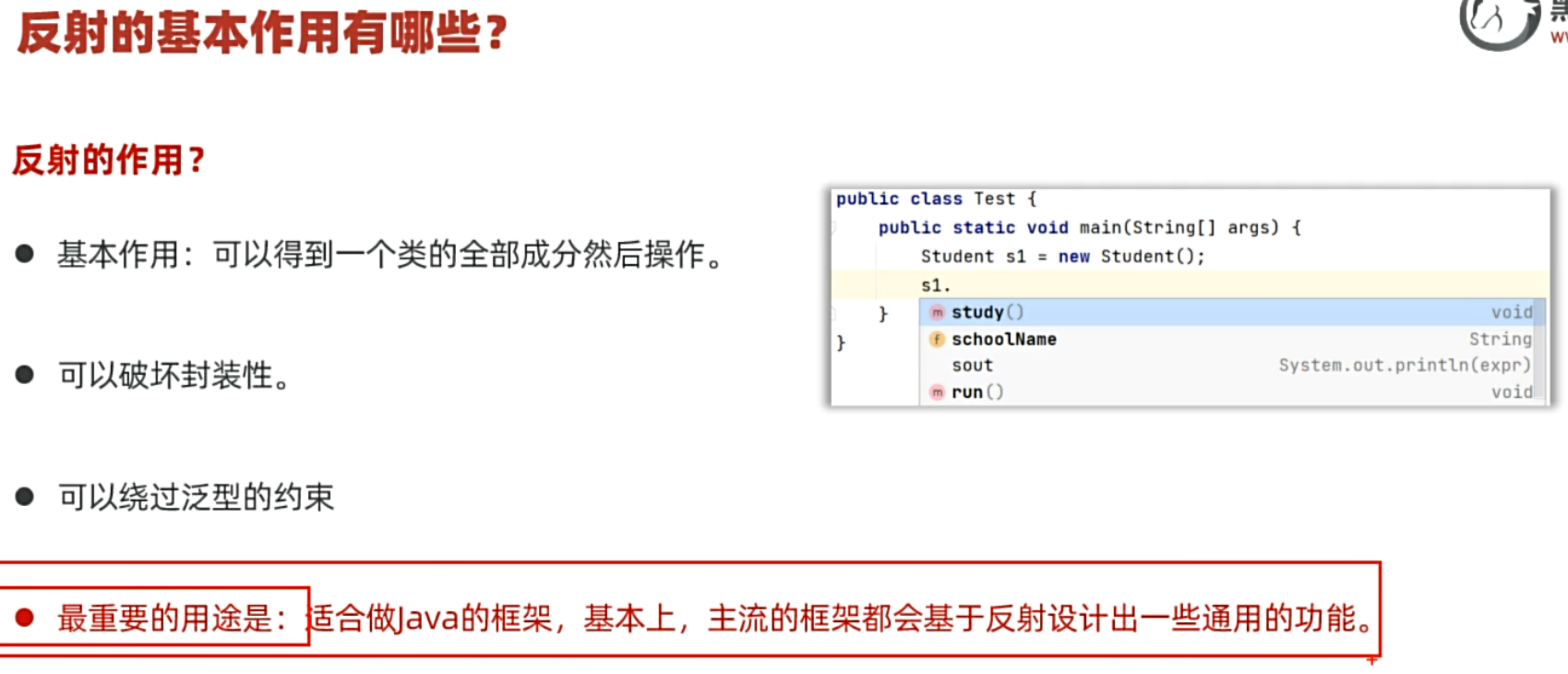
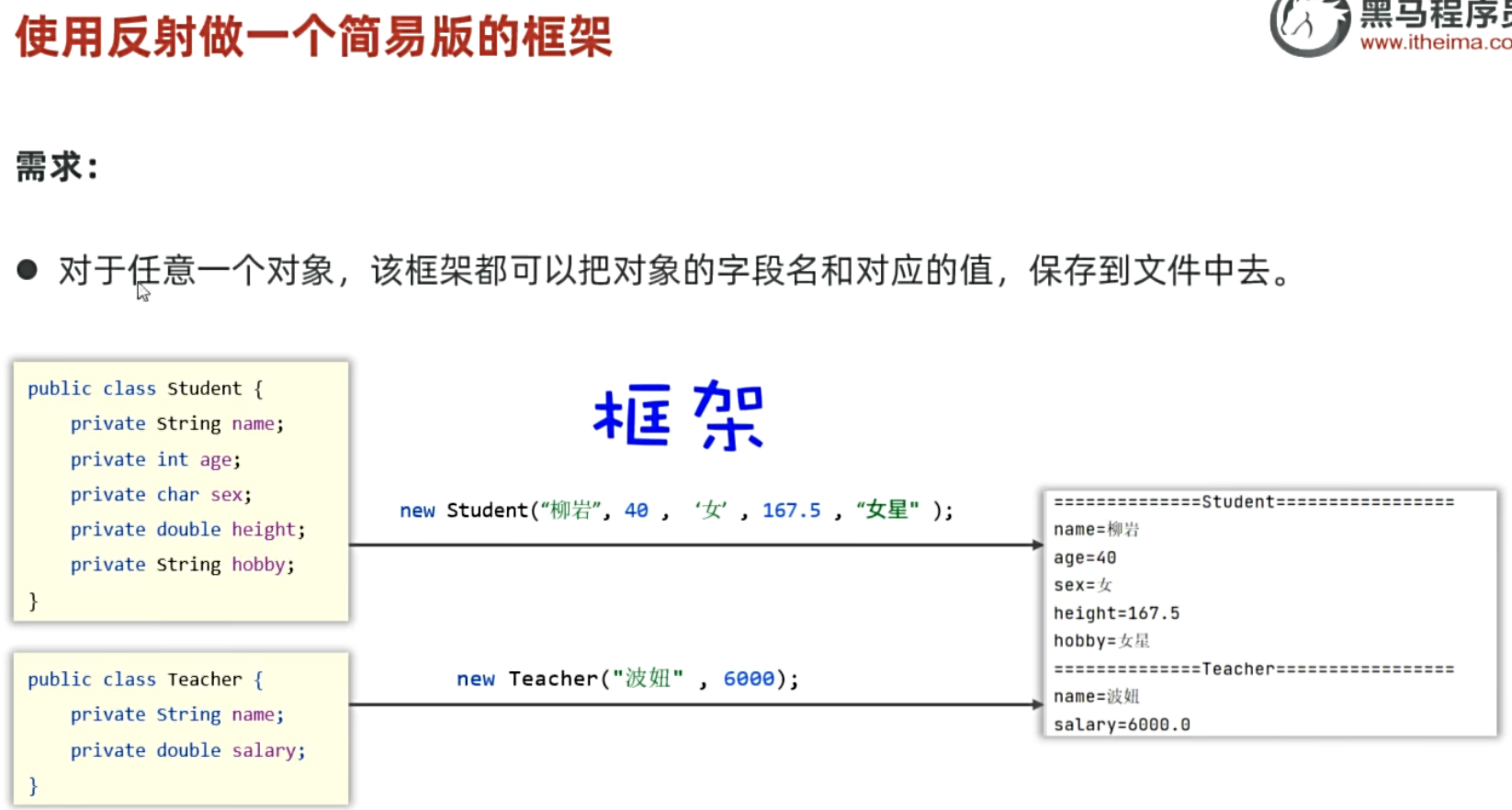
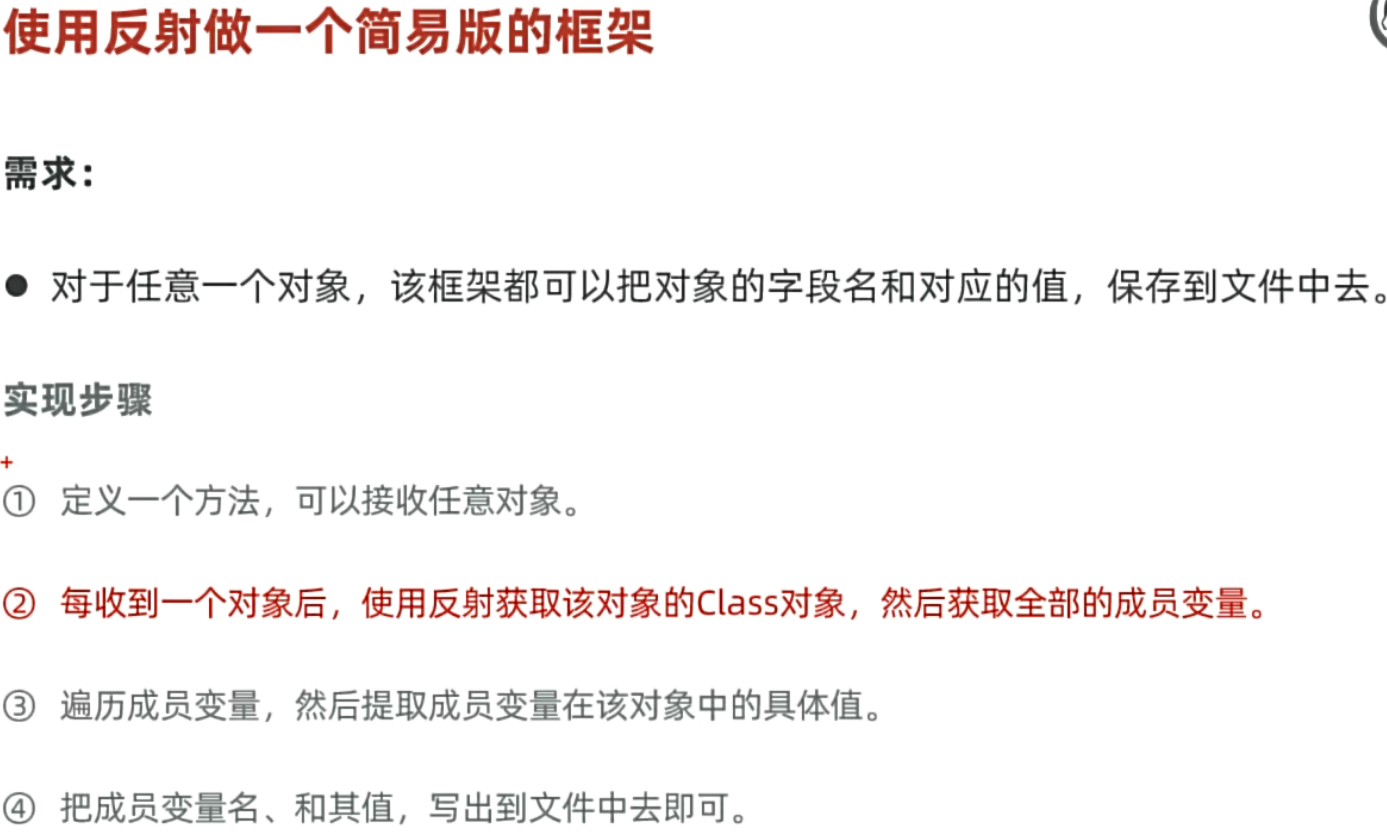
package com.itheima.d2_reflect;
import java.io.FileOutputStream;
import java.io.PrintStream;
import java.lang.reflect.Field;
public class SaveObjectFrame {
//保存任意对象的静态方法
public static void saveObject(Object obj) throws Exception {
PrintStream ps = new PrintStream(new FileOutputStream("day14-" +
"junit-reflect-annotation-proxy/src/obj2.txt",true));
//obj可能是老师,学生,猫
//只有反射可以知道对象有多少个字段
//1.获取Class对象
Class c = obj.getClass();
String simpleName = c.getSimpleName();
ps.println("==================" + simpleName + "====================");
//2.获取Class对象的所有字段
Field[] fields = c.getDeclaredFields();
//3.遍历字段
for (Field field : fields) {
//4.获取字段的值
//4.1 获取字段名称
String fieldName = field.getName();
//4.2 获取字段的值
field.setAccessible(true);//暴力反射
Object fieldValue = field.get(obj) + "";
//5.打印到文件中去
ps.println(fieldName + "=" + fieldValue);
}
ps.close();
}
}
package com.itheima.d2_reflect;
/**
* 目标:使用反射技术:设计一个保存对象的简易版框架。
*/
public class Test5Frame {
public static void main(String[] args) throws Exception {
//目标:搞清楚反射的应用:做框架的通用技术
Cat c1 = new Cat("加菲", 3);
// 需求:把任意对象的字段名和其对应的值等信息,保存到文件中去。
SaveObjectFrame.saveObject(c1);
//创建学生对象
Student s1 = new Student("黑马吴彦祖", 45, '男', 185.3, "蓝球,冰球,阅读");
SaveObjectFrame.saveObject(s1);
//创建老师对象
Teacher t1 = new Teacher("小王", 35, "打篮球", 5000, "JAVA班",'男',"屁股");
SaveObjectFrame.saveObject(t1);
}
}
3.注解
3.1 概述、自定义注解

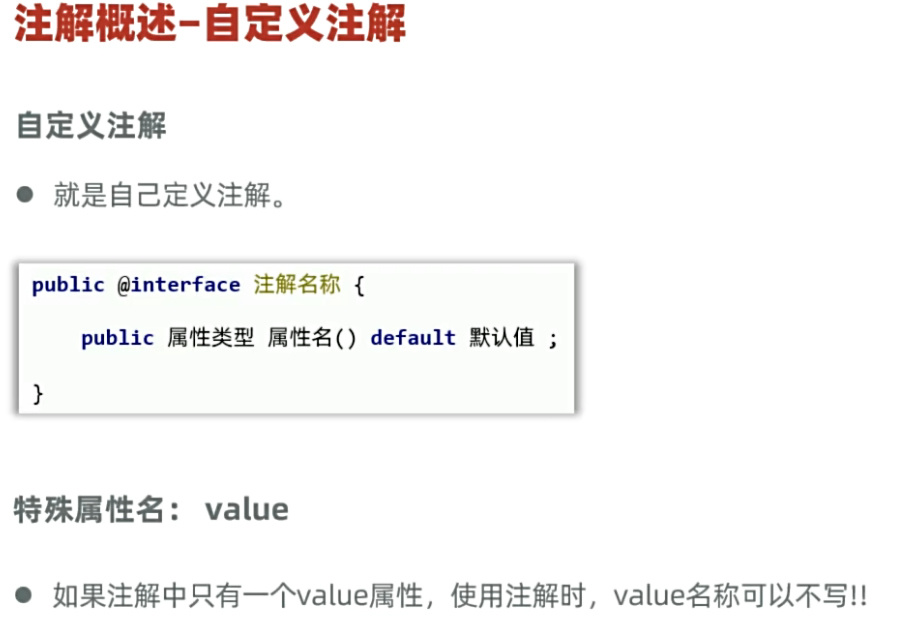
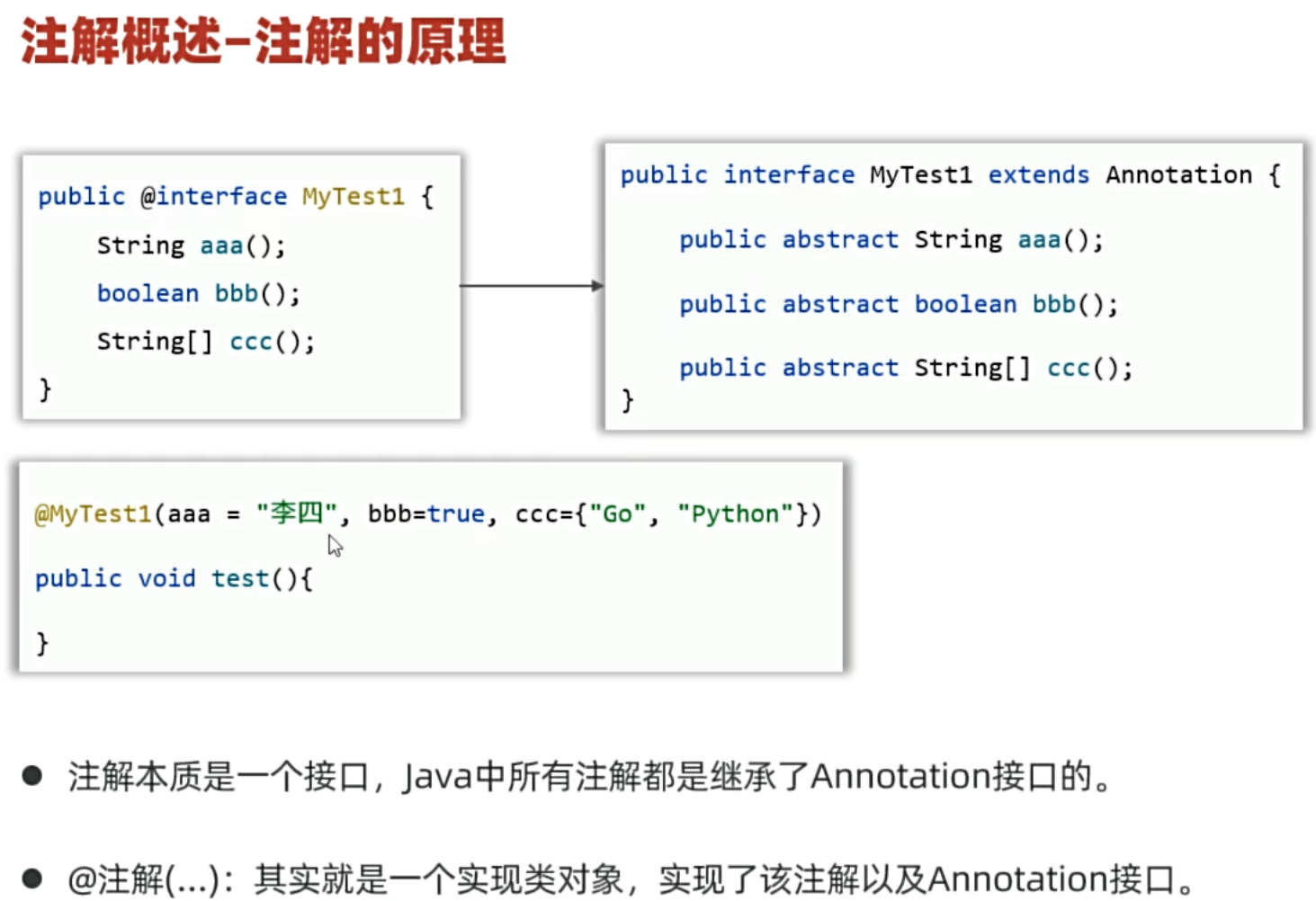
package com.itheima.d3_annotation;
// 自定义注解
public @interface MyTest {
String name();
double money() default 100;
String[] authors();
}
package com.itheima.d3_annotation;
public @interface MyTest2 {
String value();//特殊属性,在使用时如果只有一个value属性,那么在使用时value可以省略
int age() default 70;//有默认值可以不写
}
package com.itheima.d3_annotation;
@MyTest(name = "从入门到跑路", money = 9.9, authors = {"阿猫", "阿狗"})
//@MyTest2(value = "删除")
//@MyTest2(value = "删除", age = 23)
@MyTest2("删除")
public class AnnotationDemo1 {
@MyTest(name = "从入门到跑路2", authors = {"阿猫2", "阿狗2"})
private String name;
@MyTest(name = "从入门到跑路", authors = {"阿猫", "阿狗"})
public static void main(String[] args) {
// 目标:掌握注解的使用。
@MyTest(name = "从入门到跑路3", authors = {"阿猫3", "阿狗3"})
int age = 12;
}
}
3.2 元注解
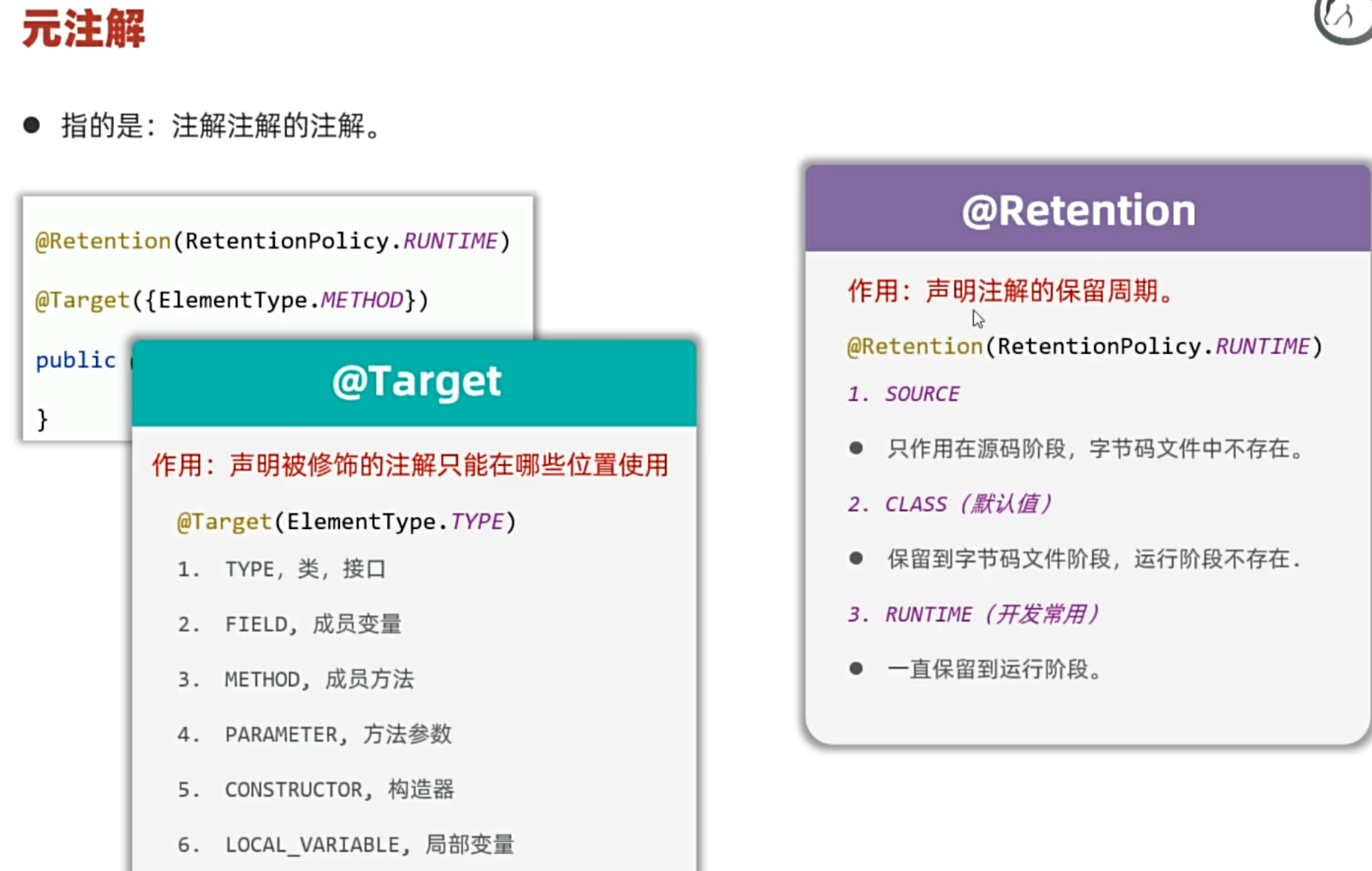
package com.itheima.d3_annotation;
import java.lang.annotation.ElementType;
import java.lang.annotation.Retention;
import java.lang.annotation.RetentionPolicy;
import java.lang.annotation.Target;
@Target({ElementType.METHOD,ElementType.TYPE}) // 声明注解的范围,只能注解方法和类
@Retention(RetentionPolicy.RUNTIME) // 这个注解始终活着
public @interface MyTest3 {
}
package com.itheima.d3_annotation;
@MyTest3
public class AnnotationDemo2 {
// @MyTest3
private String name;
// @MyTest3
public AnnotationDemo2(){
}
@MyTest3
public void run(){
}
@MyTest3
public static void main(String[] args) {
// 目标:元注解
}
}
3.3 注解的解析
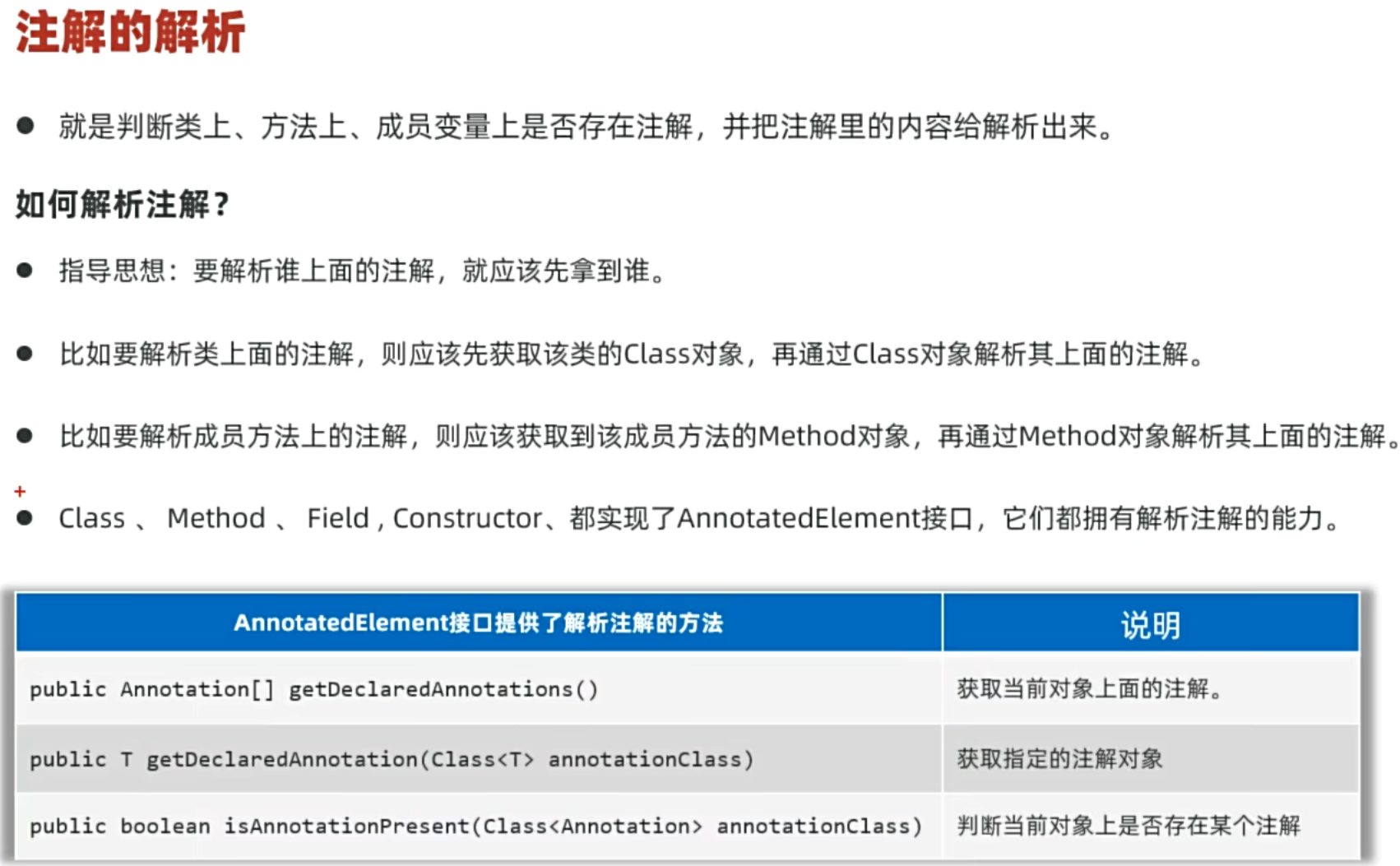
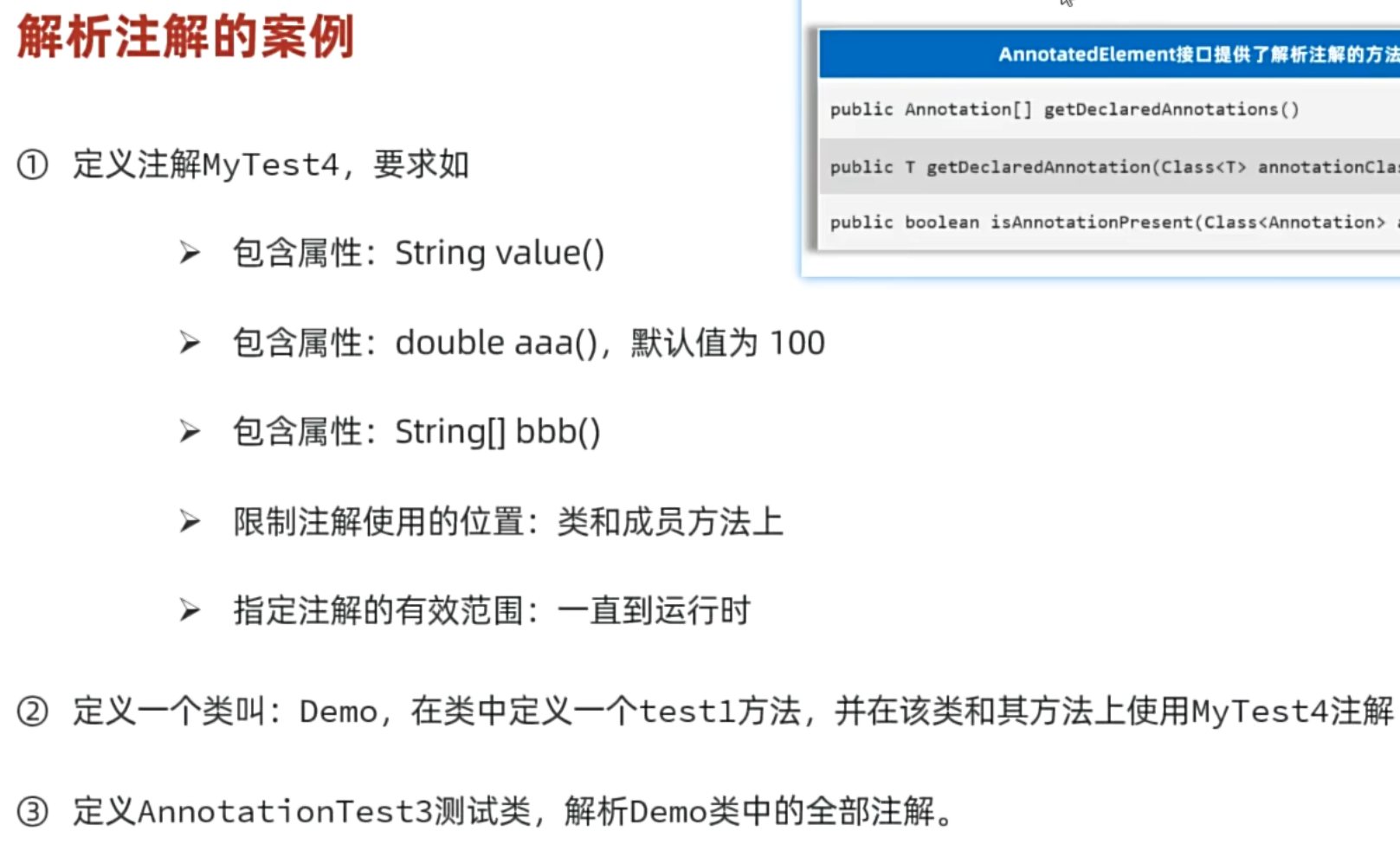
package com.itheima.d3_annotation;
import java.lang.annotation.ElementType;
import java.lang.annotation.Retention;
import java.lang.annotation.RetentionPolicy;
import java.lang.annotation.Target;
@Target({ElementType.TYPE, ElementType.METHOD})// 声明注解的范围,只能注解方法和类
@Retention(RetentionPolicy.RUNTIME)// 这个注解始终活着
public @interface MyTest4 {
String value();
double aaa() default 100;
String[] bbb();
}3.4 注解的应用场景
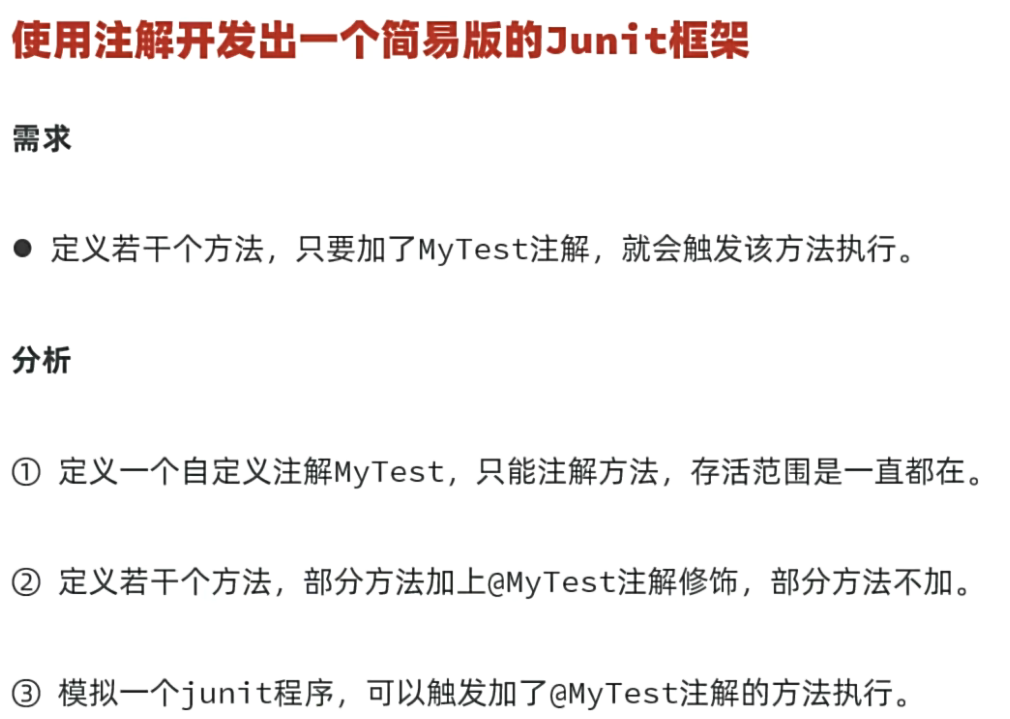
package com.itheima.d3_annotation;
import java.lang.annotation.ElementType;
import java.lang.annotation.Retention;
import java.lang.annotation.RetentionPolicy;
import java.lang.annotation.Target;
@Target(ElementType.METHOD)// 声明注解的范围,只能注解方法
@Retention(RetentionPolicy.RUNTIME)// 这个注解始终活着
public @interface TestDlei {
int value() default 1;
}
package com.itheima.d3_annotation;
import java.lang.reflect.Method;
public class AnnotationDemo4 {
// 目标:搞清楚注解的应用场景:模拟junit框架。有TestDlei注解的方法,就执行这个方法。
//测试方法:public 无参 无返回值
public void test1() {
System.out.println("===========test1=======");
}
@TestDlei
public void test2() {
System.out.println("===========test2=======");
}
public void test3() {
System.out.println("===========test3=======");
}
@TestDlei(2)// value() = 2
public void test4() {
System.out.println("===========test4=======");
}
public static void main(String[] args) throws Exception {
AnnotationDemo4 t = new AnnotationDemo4();
//1.获取类对象
// 有注解的跑他,没有注解的不跑他
Class c = AnnotationDemo4.class;
//2.获取所有方法
Method[] methods = c.getDeclaredMethods();
//3.遍历所有方法,判断方法上是否有注解
for (Method method : methods) {
// 4.判断这个方法上是否陈列了注解,是就跑
if(method.isAnnotationPresent(TestDlei.class)){
//获取到这个方法的注解
TestDlei testDlei = method.getDeclaredAnnotation(TestDlei.class);
int value = testDlei.value();
//5.有就执行这个method方法
for (int i = 0; i < value; i++) {
method.invoke(t);//invoke(Object obj, Object... args)必须用对象调用
}
}
}
}
}
4.动态代理
4.1什么是代理?
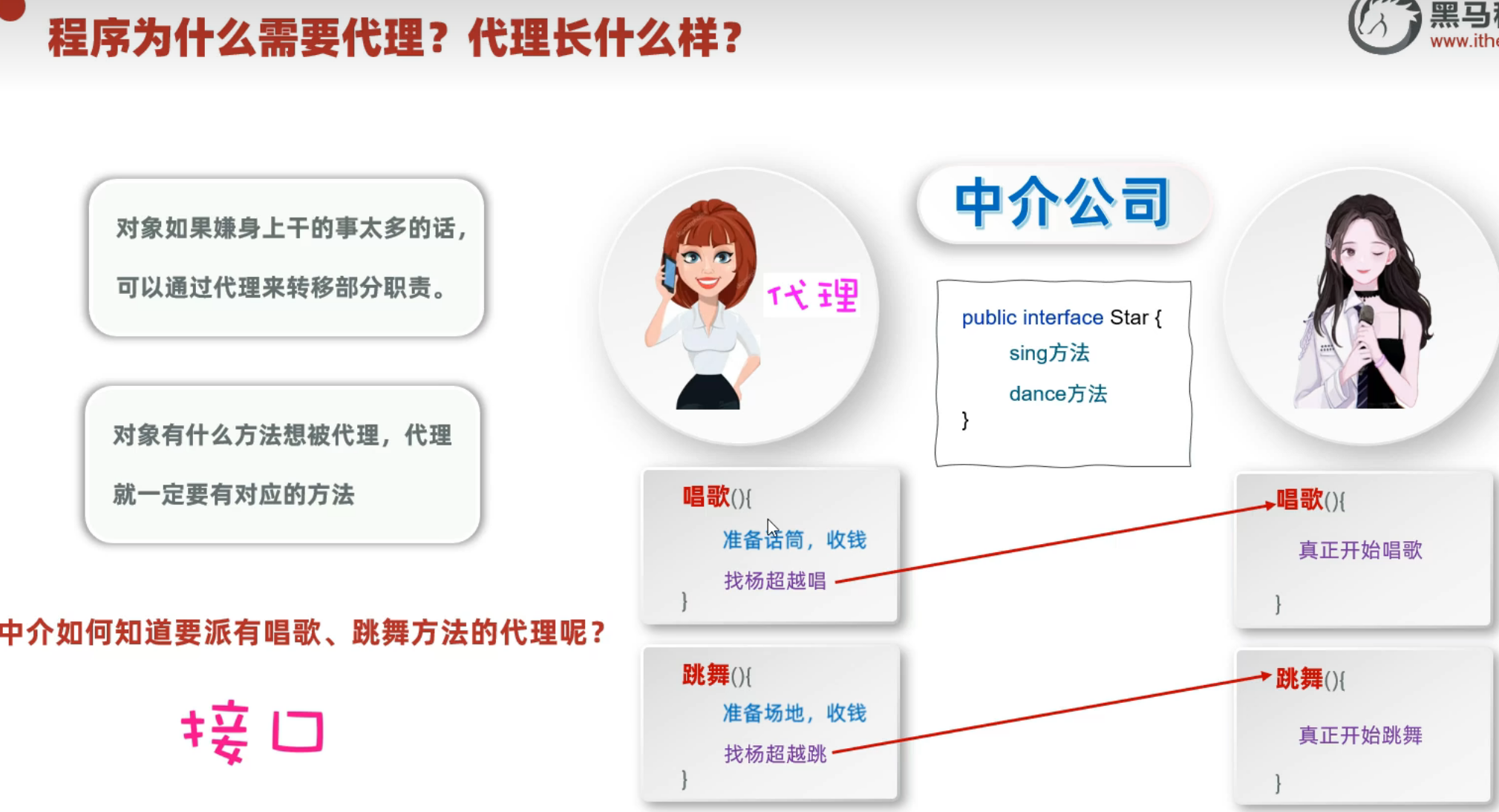

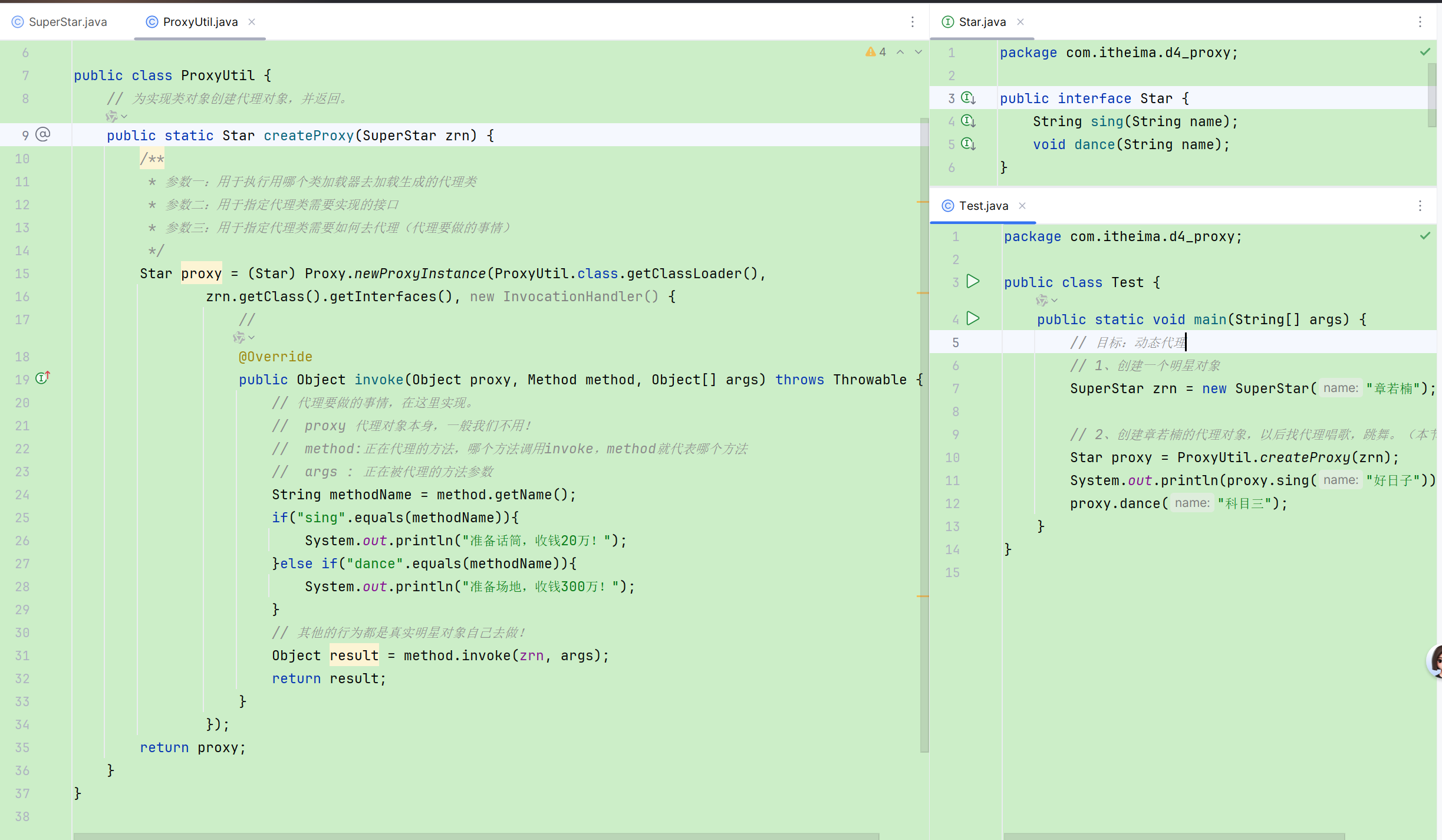
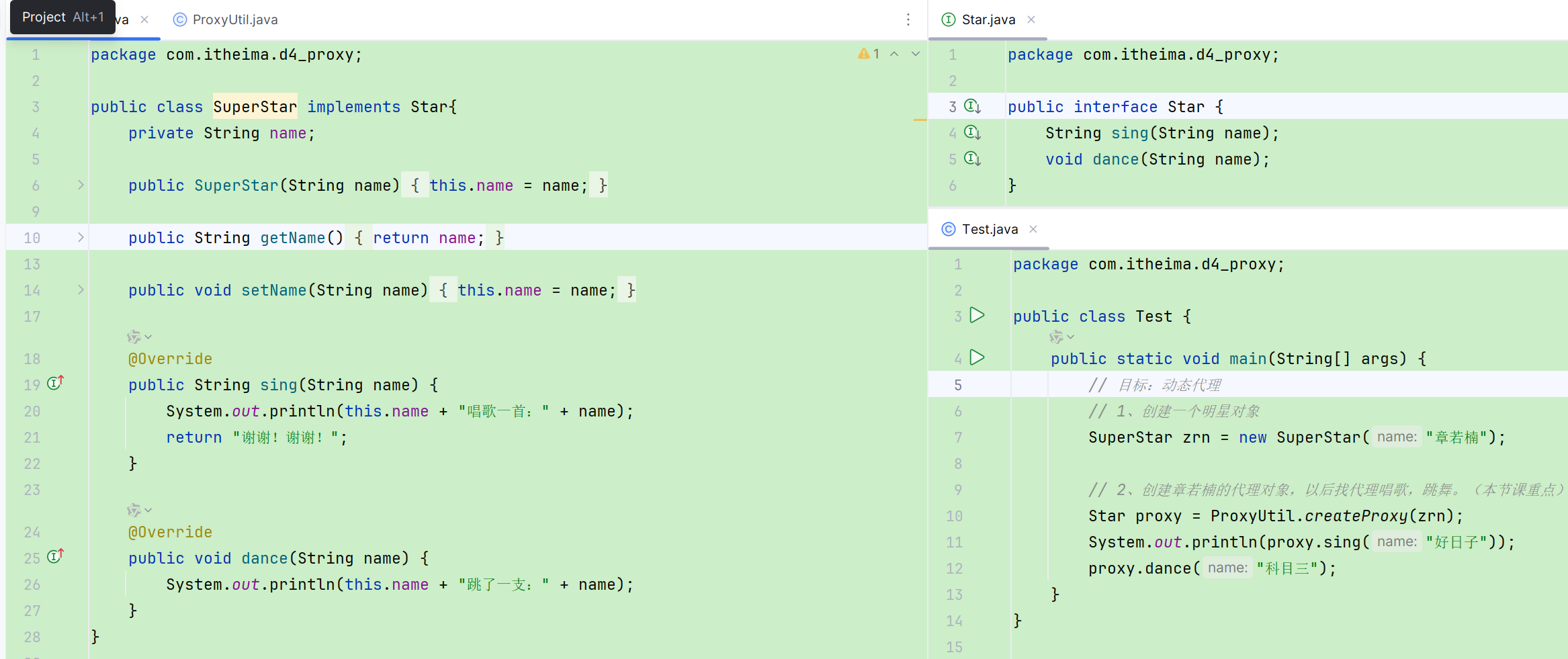
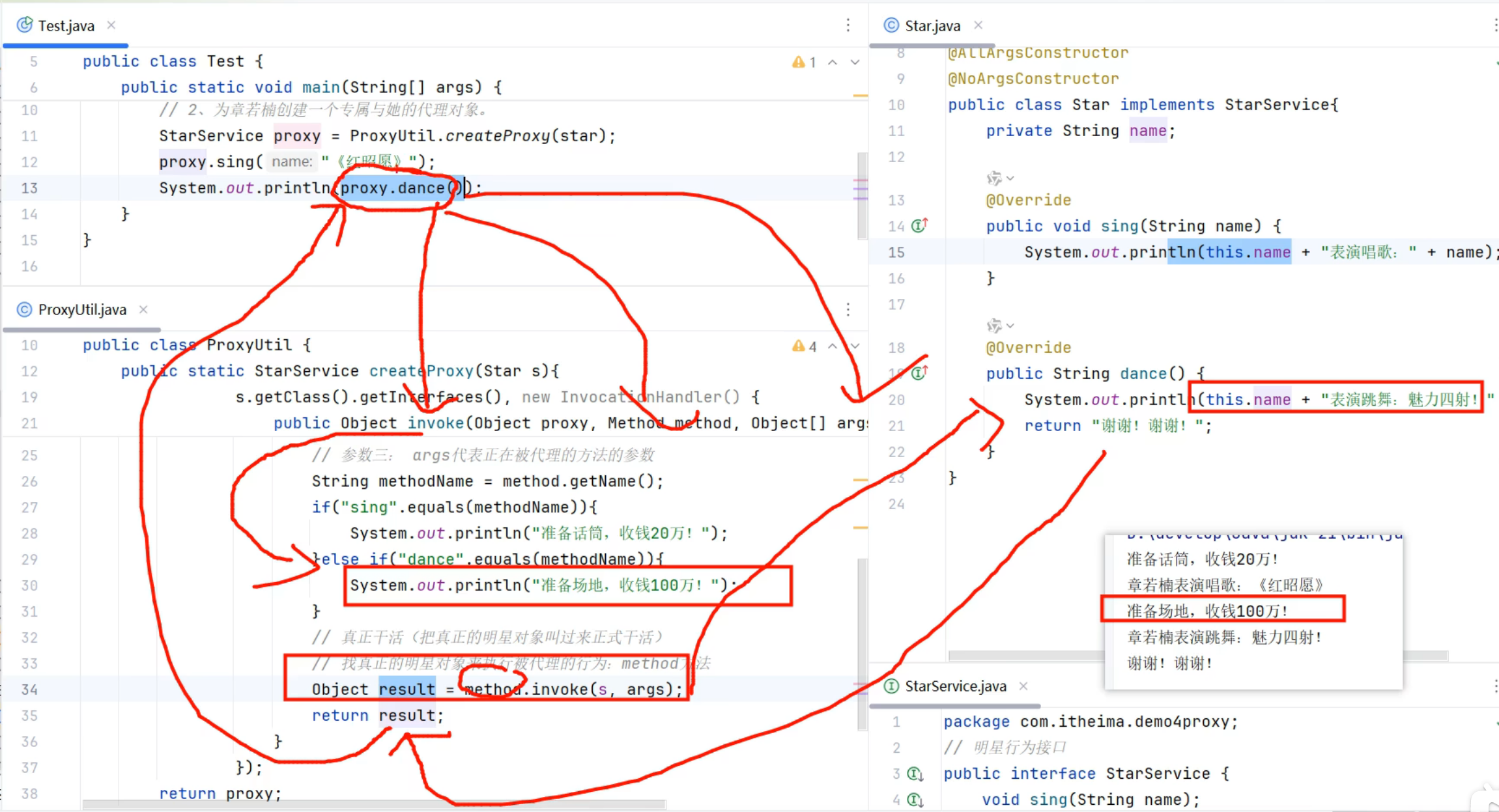 4.2 动态代理解决实际问题
4.2 动态代理解决实际问题
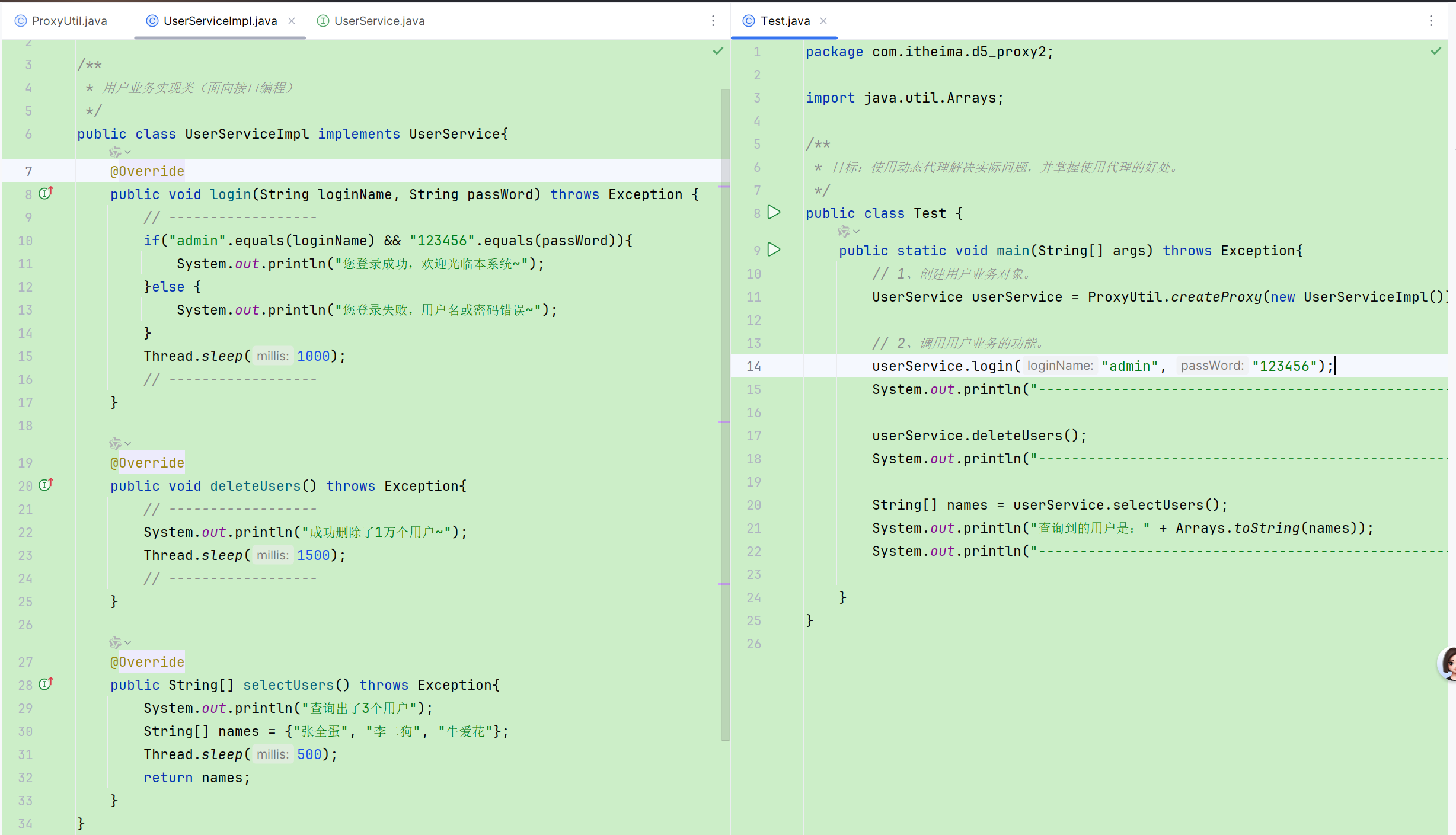
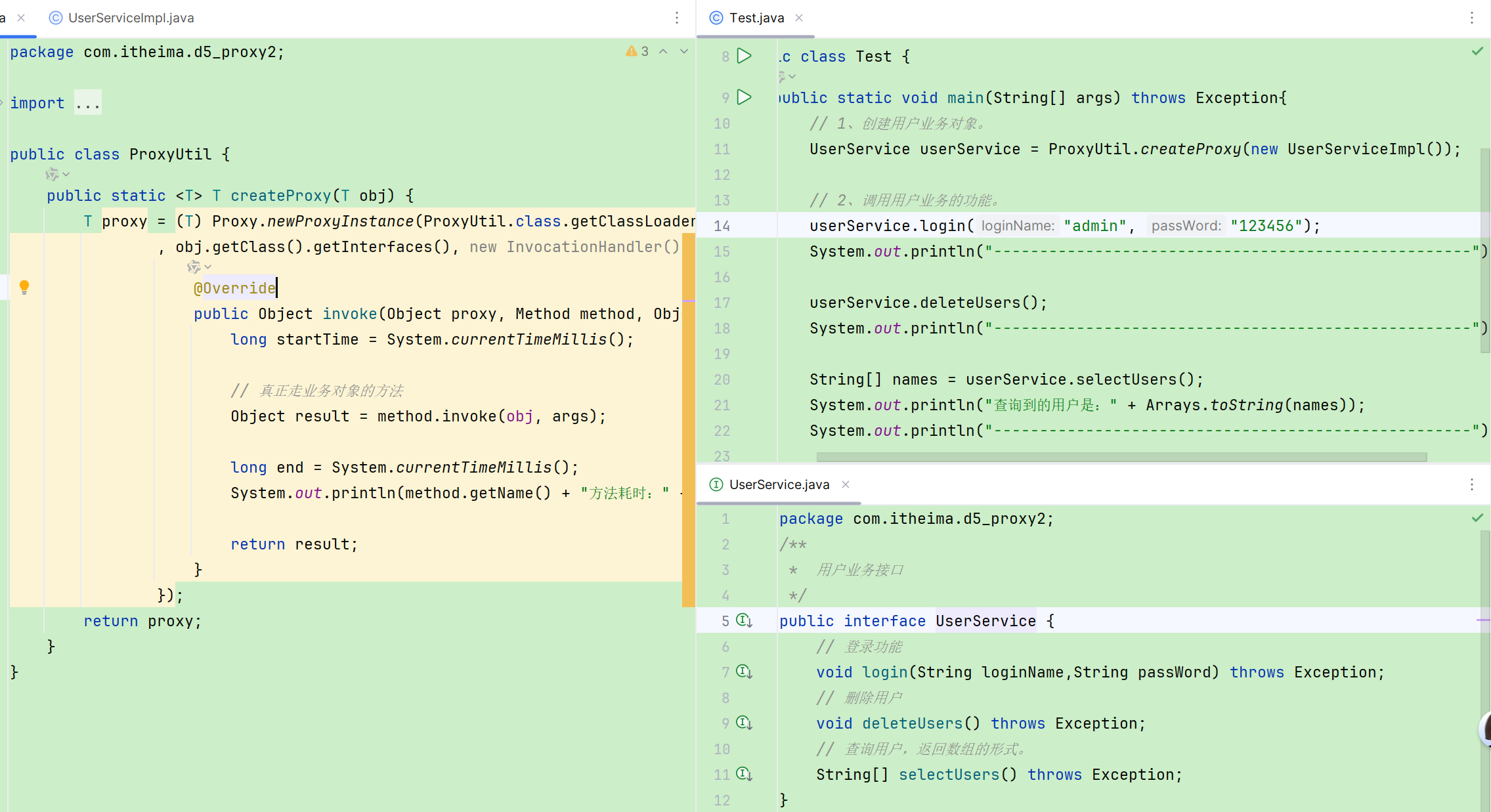
import java.lang.reflect.InvocationHandler;
import java.lang.reflect.Method;
import java.lang.reflect.Proxy;
public class ProxyUtil {
public static <T> T createProxy(T obj) {
T proxy = (T) Proxy.newProxyInstance(ProxyUtil.class.getClassLoader()
, obj.getClass().getInterfaces(), new InvocationHandler() {
@Override
public Object invoke(Object proxy, Method method, Object[] args) throws Throwable {
long startTime = System.currentTimeMillis();
// 真正走业务对象的方法
Object result = method.invoke(obj, args);
long end = System.currentTimeMillis();
System.out.println(method.getName() + "方法耗时:" + (end - startTime) / 1000.0);
return result;
}
});
return proxy;
}
}
可以把这个代理类改为泛型类,这样无论哪个接口的实现类都可以实现代理类想要实现的功能,如计算运行速度。




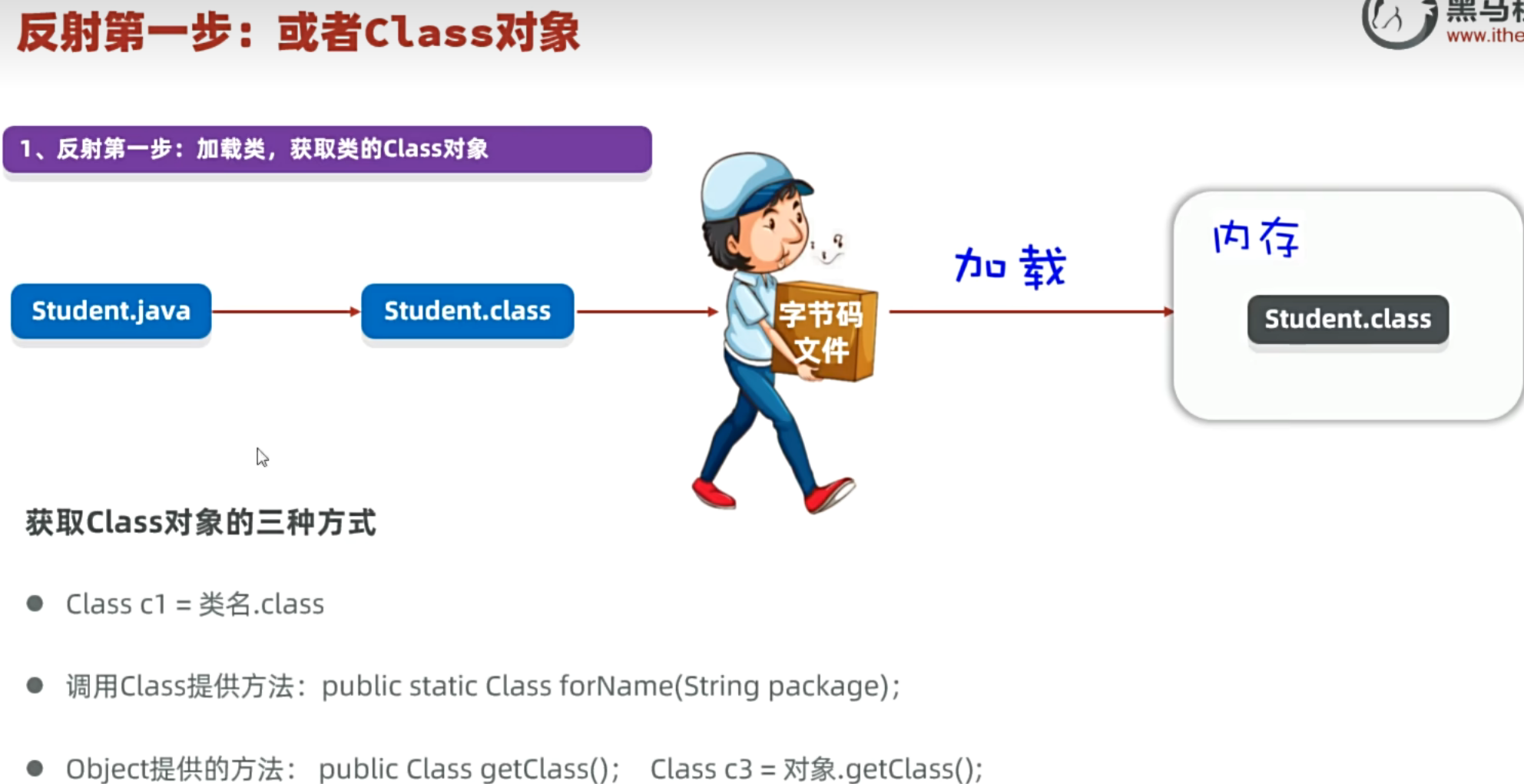
















 1302
1302

 被折叠的 条评论
为什么被折叠?
被折叠的 条评论
为什么被折叠?








